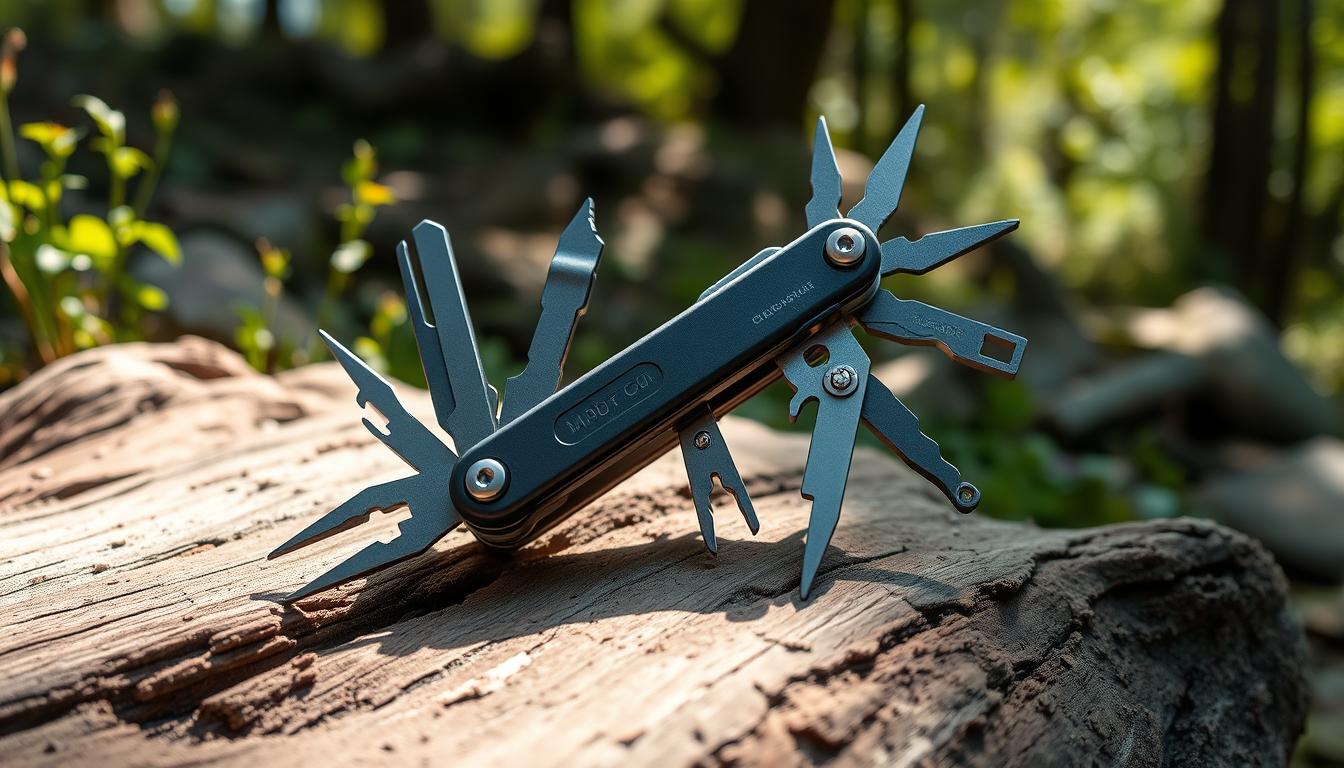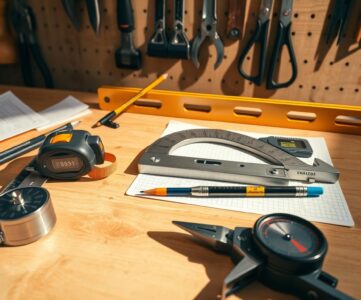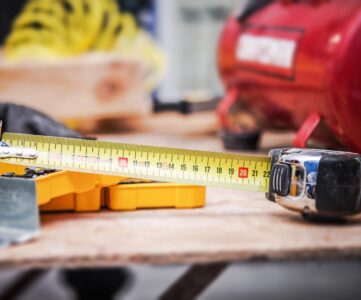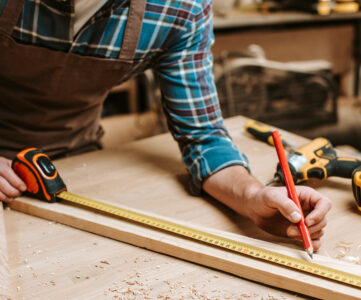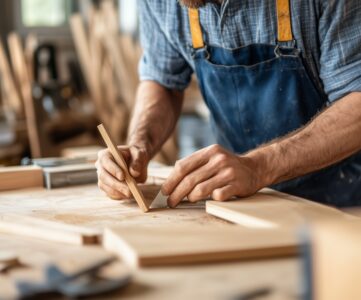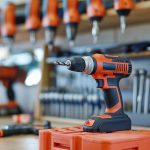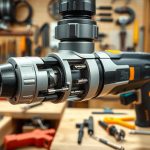A multi-tool is a handheld device that does many things like cutting, sawing, and grinding. It’s a versatile tool for many tasks. With the right multi-tool, you can handle DIY projects and professional construction work.
Imagine having one tool for many tasks. This makes it a must-have in your toolkit. The world of multi-tools is vast and exciting. It offers endless possibilities for DIY enthusiasts and professional contractors alike.
In this article, we’ll explore the world of multi-tools. We’ll look at their history, evolution, and the types available today. We’ll also highlight the benefits of versatile tools and their applications.
Key Takeaways
- A multi-tool is a handheld device that combines several functions into one convenient tool.
- Multi-tools are versatile tools for various applications, including DIY projects and professional construction work.
- There are numerous tool applications waiting to be explored with a multi-tool.
- A multi-tool can be an essential item in your toolkit for multiple tasks.
- Understanding the different types of multi-tools can help you choose the right one for your needs.
- Multi-tools can help you tackle a wide range of tasks, from cutting and sawing to grinding and more.
Understanding the Modern Multi-Tool Revolution
The modern multi-tool has evolved a lot. Thanks to technology, they are now more versatile and efficient. They offer a wide range of multi-tool uses for different needs and industries.
One reason multi-tools are so popular is their tool versatility. For example, an oscillating tool can do many things like cutting, sanding, and scraping. It’s a must-have in any toolkit.
Evolution of Multi-Tools
Multi-tools have changed a lot over the years. They now have new features and technologies, making them more powerful. The shift from manual to power-driven tools has been big. It’s all about improving tool versatility and multi-tool uses.
Key Features and Components
Modern multi-tools have cool features like ergonomic design, high-quality blades, and strong motors. These help users do many tasks easily and accurately. This makes oscillating tools a hit among professionals and DIY fans.
Types of Multi-Tools Available Today
Now, there are many types of multi-tools for different needs and industries. Some top ones include:
- Combination tools
- Rotary tools
- Oscillating tools
The Essential Multi-Tool Buying Guide
Choosing a DIY multi-tool involves several key factors. Your intended use, budget, and personal preferences are all important. Tool applications can range from cutting and sawing to sanding and grinding. So, think about how you’ll use your multi-tool.
A DIY multi-tool is a great addition to any toolkit. It offers many functions in one device. To make the most of your multi-tool, consider these points:
- Intended use: What tasks do you want to perform with your multi-tool?
- Budget: How much are you willing to spend on a DIY multi-tool?
- Personal preferences: Do you prefer a cordless or corded model?
By thinking about these factors, you can find a DIY multi-tool that suits your needs. It will help you with various tool applications. With the right multi-tool, you’ll be ready for any task.
Do your research and compare different models before buying. If you have questions, don’t hesitate to ask manufacturers or experts. With some knowledge and planning, you’ll find the perfect DIY multi-tool for your next project.
| Multi-Tool Type | Features | Price Range |
|---|---|---|
| Cordless | Portable, convenient, and easy to use | $50-$200 |
| Corded | More powerful, with a consistent energy supply | $30-$150 |
Power and Precision: Core Functions of Multi-Tools
Multi-tools are known for their versatile tools and ability to perform a variety of tasks. They can cut, saw, sand, grind, scrape, and remove. These functions make them essential for many projects, like woodworking, metalworking, and drywall repair.
One of the key features of multi-tools is their use of oscillating blades. These blades allow for precise cutting and sawing. They can handle a range of materials, from wood and metal to plastic and drywall. With the right attachment, a multi-tool can become a powerful saw, capable of making quick work of even the toughest materials.
Cutting and Sawing Capabilities
When it comes to cutting and sawing, multi-tools offer a level of precision and control that is hard to match with traditional tools. The oscillating blades used in these tools allow for smooth, consistent cuts. They are ideal for a variety of applications. Whether you’re working with wood, metal, or drywall, a multi-tool with the right blade can make the job easier and more efficient.
Sanding and Grinding Functions
In addition to cutting and sawing, multi-tools also offer sanding and grinding functions. These functions are made possible by the use of specialized attachments, such as sanding pads and grinding stones. With these attachments, a multi-tool can be used to smooth out rough surfaces, remove old finishes, and prepare surfaces for new coatings.
Overall, the core functions of multi-tools make them versatile tools that can be used in a wide range of applications. From cutting and sawing to sanding and grinding, these tools offer a level of precision and control that is hard to match with traditional tools. With the right attachments and a little practice, a multi-tool can become an essential part of your toolkit.
DIY Project Game-Changers: Multi-Tool Applications
Having the right tools is crucial for DIY projects. A multi-tool is incredibly versatile, making it a must-have. It’s perfect for tasks in woodworking and metalworking, changing the game for DIY fans.
Using a multi-tool makes DIY projects easier. It lets you cut, saw, and scrape with one tool. This means you don’t need to carry many tools, making work in tight spaces simpler. Plus, it’s great for sanding and grinding, helping you get professional results.
- Woodworking projects, such as building furniture or repairing decks
- Metalworking projects, such as repairing bikes or creating metal art
- Home repair tasks, such as fixing leaky faucets or patching drywall
Adding a multi-tool to your DIY projects saves time and boosts efficiency. It helps you achieve top-notch results. With its many uses, a multi-tool is a key tool for DIY enthusiasts.
Professional Uses in Construction and Remodeling
Multi-tools are key in construction and remodeling. They offer many benefits for professionals. These tools are versatile and adaptable, making them perfect for many tasks. The oscillating tool is a favorite for its precision and control.
In woodworking, multi-tools help with cutting, sanding, and grinding. They’re also great for metal tasks like cutting and grinding pipes and sheets. Plus, they’re useful for drywall and finishing work, like cutting and sanding drywall and applying joint compound.
Woodworking Projects
Woodworking projects often use multi-tools for:
- Cutting and shaping wood
- Sanding and grinding wood surfaces
- Assembling and disassembling furniture
Metal Fabrication Tasks
Metal tasks that benefit from multi-tools include:
- Cutting and grinding metal pipes and sheets
- Drilling and tapping metal holes
- Welding and soldering metal joints
Drywall and Finishing Work
For drywall and finishing, multi-tools are used for:
- Cutting and sanding drywall
- Applying joint compound and tape
- Sanding and finishing drywall surfaces
| Task | Multi-Tool Function |
|---|---|
| Woodworking | Cutting, sanding, grinding |
| Metal Fabrication | Cutting, grinding, drilling |
| Drywall and Finishing | Cutting, sanding, applying joint compound |
Maximizing Your Multi-Tool’s Versatility
To get the most out of your DIY multi-tool, it’s key to know its tool versatility. This lets you use it in many projects. With the right attachments, your multi-tool becomes a must-have in your workshop or toolbox.
Attachments like saw blades, grinding stones, and sanding drums are crucial. They help with cutting, sanding, grinding, and polishing. By trying out different uses, you can reach your multi-tool’s full potential. This boosts your DIY projects.
Here are some tips to make the most of your multi-tool’s versatility:
- Try out different attachments and accessories to see what works best for you.
- Practice using your multi-tool in various ways to improve your skills and confidence.
- Keep up with the latest in multi-tool technology to stay ahead.
By following these tips and embracing your DIY multi-tool’s tool versatility, you open up a world of creative possibilities. This takes your DIY projects to new levels.
Essential Accessories and Attachments
To get the most out of your multi-tool, you need the right accessories and attachments. These can make your tool more useful. Oscillating blades are great for cutting and sanding. Saw blades are better for cutting through thick materials.
Having the right attachments is key for versatile tools. Attachments like sanding drums, scraping blades, and grinding stones are useful. They help with tasks like smoothing wood or removing old adhesive.
- Extra blades and attachments
- Tool cases for storage and transport
- Extra batteries and chargers
| Accessory | Description |
|---|---|
| Oscillating blades | Used for cutting and sanding |
| Saw blades | Used for cutting through thicker materials |
| Sanding drums | Used for smoothing out surfaces |
With the right accessories and attachments, your multi-tool can do even more. It becomes a more versatile tool in your toolkit.
Maintenance and Care Tips for Longevity
To keep your multi-tool in top shape, regular care is crucial. Clean and oil it after each use. Also, store it in a dry spot. This care routine will help your multi-tool last longer and work better for many tasks.
Here are some tips to keep your multi-tool in great condition:
- Regularly clean the tool to prevent dirt and debris buildup
- Lubricate moving parts to reduce friction and wear
- Store the tool in a protective case or pouch when not in use
By following these easy tips, your multi-tool will stay reliable and handy for many tasks. Regular maintenance is essential to get the best out of your multi-tool and make it last longer.
Safety Guidelines and Best Practices
Working with a DIY multi-tool requires safety first. These tools are handy but can be risky if not used right. It’s key to handle them carefully to avoid accidents.
Always wear safety gear like glasses and gloves. This protects you from sharp edges and flying debris. Also, keep the tool safe and sound to prevent damage and accidents.
Personal Protective Equipment
- Safety glasses: protect your eyes from flying debris
- Gloves: prevent cuts and abrasions on your hands
- Steel-toed shoes: protect your feet from heavy objects
Operating Safety Measures
Follow safety rules when using a DIY multi-tool. Keep your clothes and hair tied back. Don’t stretch too far and hold the tool tightly. These steps help keep you safe and your project successful.
Emergency Procedures
Have a plan for emergencies. Keep a first aid kit nearby and know basic first aid. Also, have emergency numbers ready. Being ready can help prevent serious injuries and ensure quick help when needed.
Troubleshooting Common Multi-Tool Issues
Working with multi-tools can sometimes lead to problems. These issues can be really frustrating, like when you’re in the middle of a project. We’ll look at common problems and how to solve them, focusing on the oscillating tool and other versatile tools.
Keeping your multi-tool clean and well-lubricated is crucial. It helps prevent many common issues. But, even with good care, problems can still happen. Knowing how to troubleshoot and fix these issues is very important.
Performance Problems
Some common problems include dull blades, worn-out batteries, and faulty motors. To fix these, sharpen or replace blades, charge or replace batteries, and check the motor for blockages or damage.
Quick Fixes and Solutions
For more complex problems, check the user manual or contact the manufacturer. Some quick fixes include:
- Checking and replacing worn-out parts
- Cleaning and lubricating moving parts
- Adjusting or tightening loose screws and bolts
By following these tips and keeping up with maintenance, you can keep your multi-tool working well. Whether it’s an oscillating tool or other versatile tools, knowing how to fix common problems is key for any project.
| Common Problem | Solution |
|---|---|
| Dull blades | Sharpen or replace blades |
| Worn-out batteries | Charge or replace batteries |
| Faulty motor | Check for blockages or damage and repair or replace motor |
Advanced Techniques and Expert Tips
Exploring multi-tool uses opens up a world of possibilities. Whether you’re into woodworking or metal fabrication, a multi-tool is a must-have. It can make even the toughest tasks a breeze with the right tool applications.
Some advanced ways to use a multi-tool include:
- Using the tool as a rotary tool for drilling and grinding
- Utilizing the oscillating function for sanding and scraping
- Employing the combination tool for cutting and sawing
These methods help you get the most out of your multi-tool. They expand its tool applications.
As you try out different multi-tool uses, remember that practice and patience are key. With time, you’ll master the tool for various tasks. This includes DIY projects and professional work.
By using these expert tips and techniques, you’ll unlock your multi-tool’s full potential. Whether you’re a pro or a DIY lover, the right tool applications can elevate your projects.
| Multi-Tool Function | Description |
|---|---|
| Rotary Tool | Drilling and grinding |
| Oscillating Tool | Sanding and scraping |
| Combination Tool | Cutting and sawing |
Conclusion: Embracing the Multi-Tool Advantage
The multi-tool is a must-have for DIY projects and work. It’s great for woodworking and home repairs. These tools are small but pack a big punch, making your work easier and faster.
Choosing the right multi-tool is key. Look for one that fits your needs. This way, you’ll get the most out of it. With the right care, your multi-tool will last a long time, helping you with all your tasks.
Don’t wait to try out a multi-tool. Start your next project with confidence. You’ll have a reliable tool ready to help you with any task.
